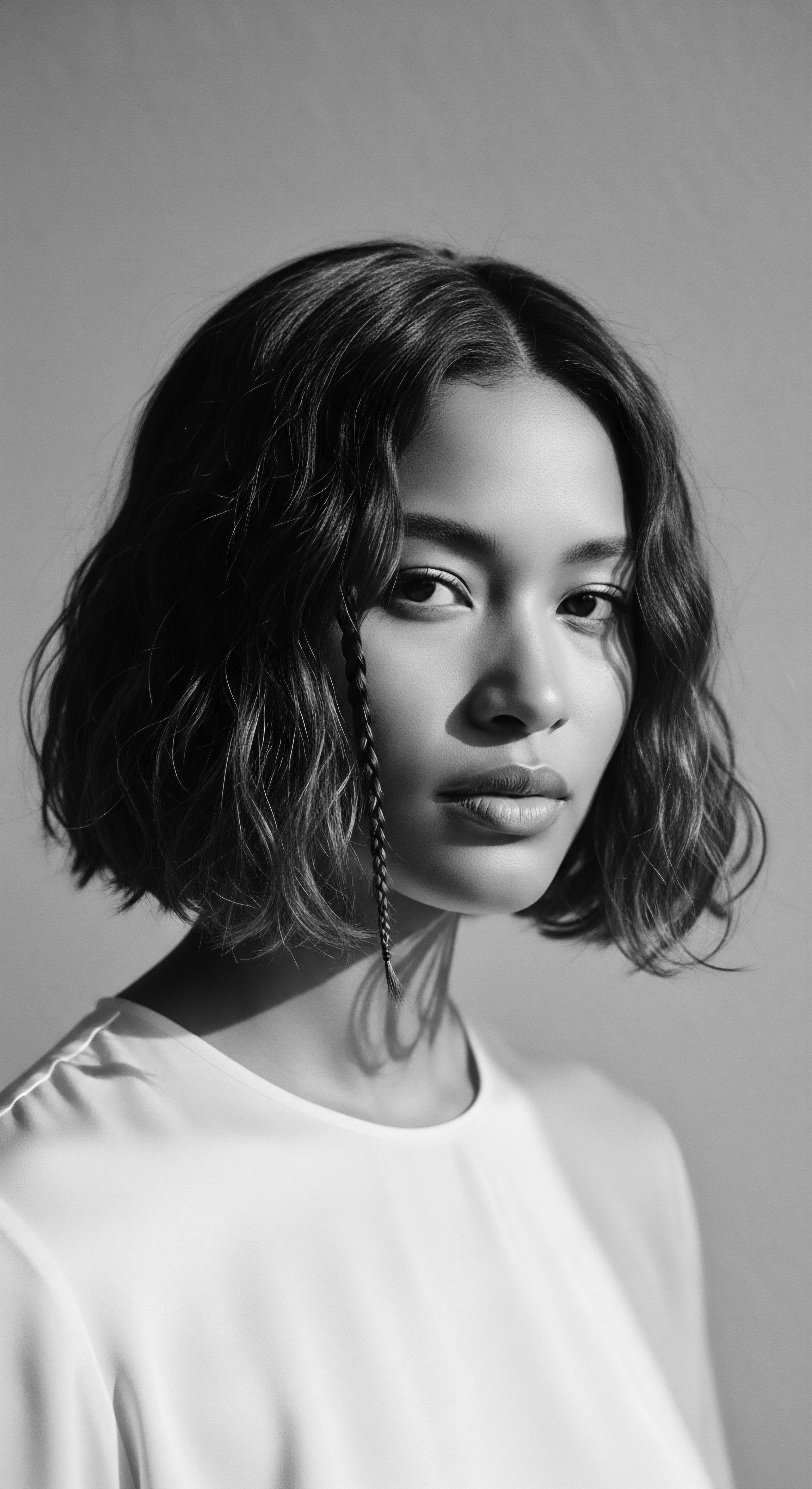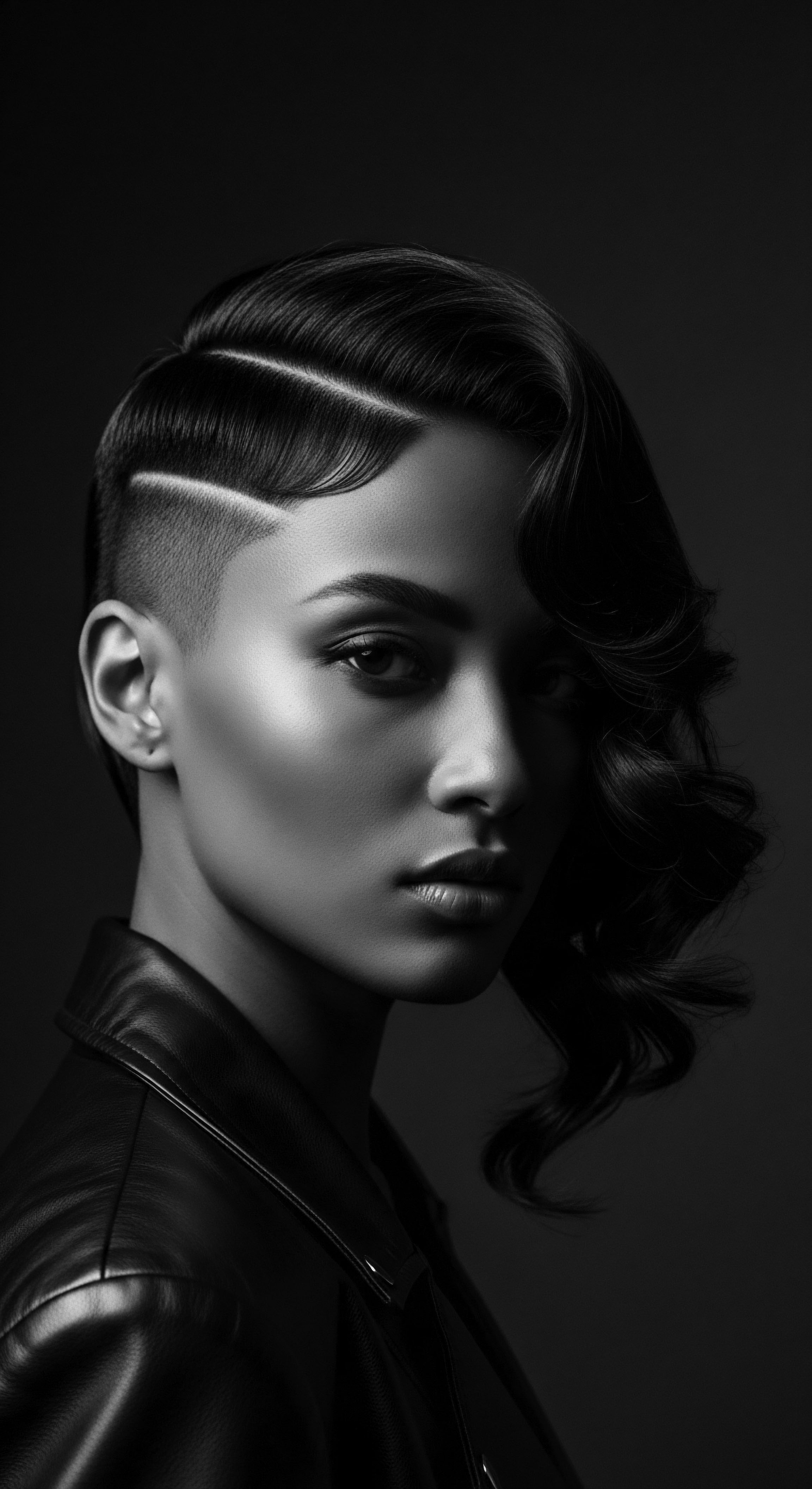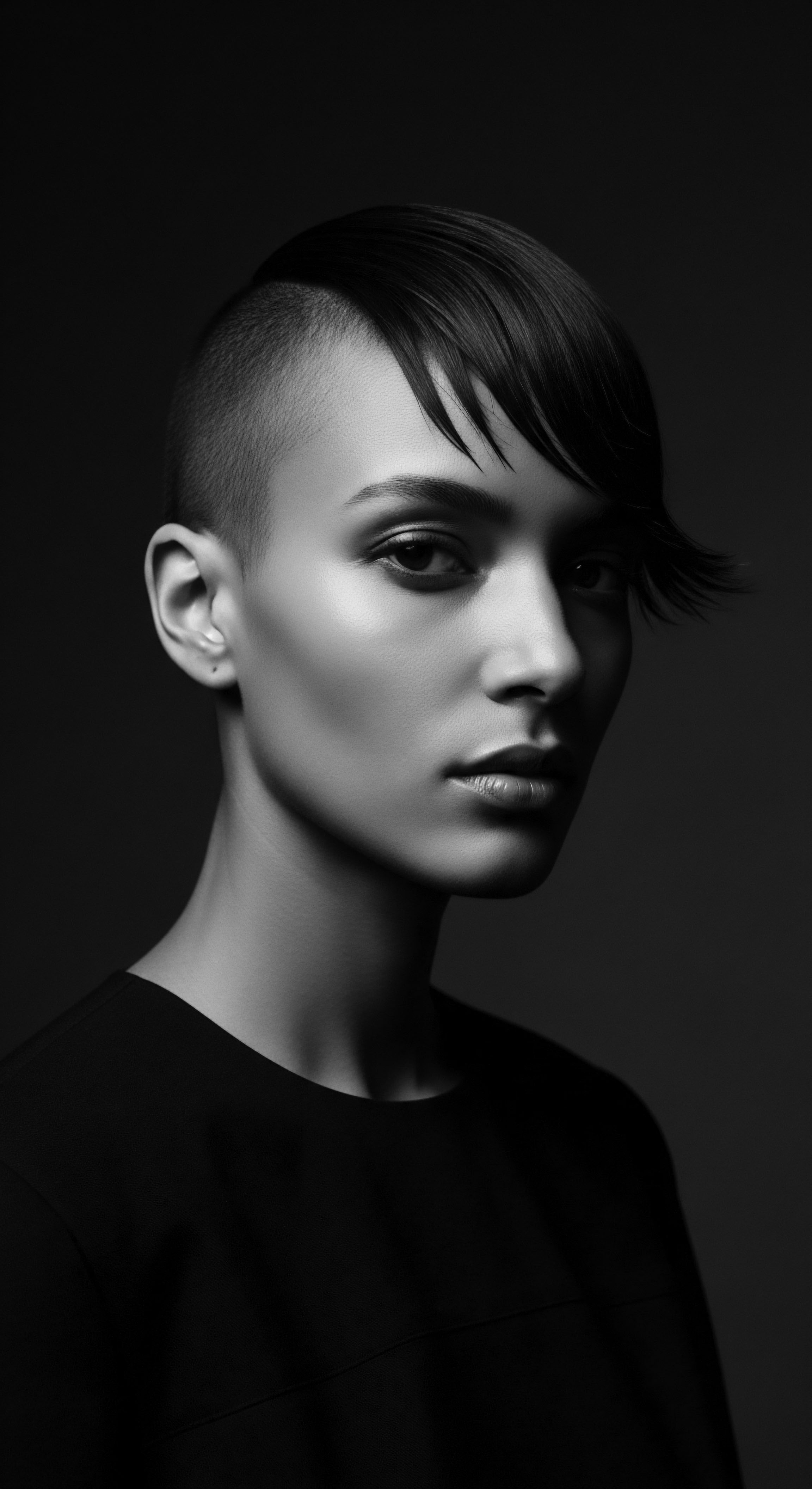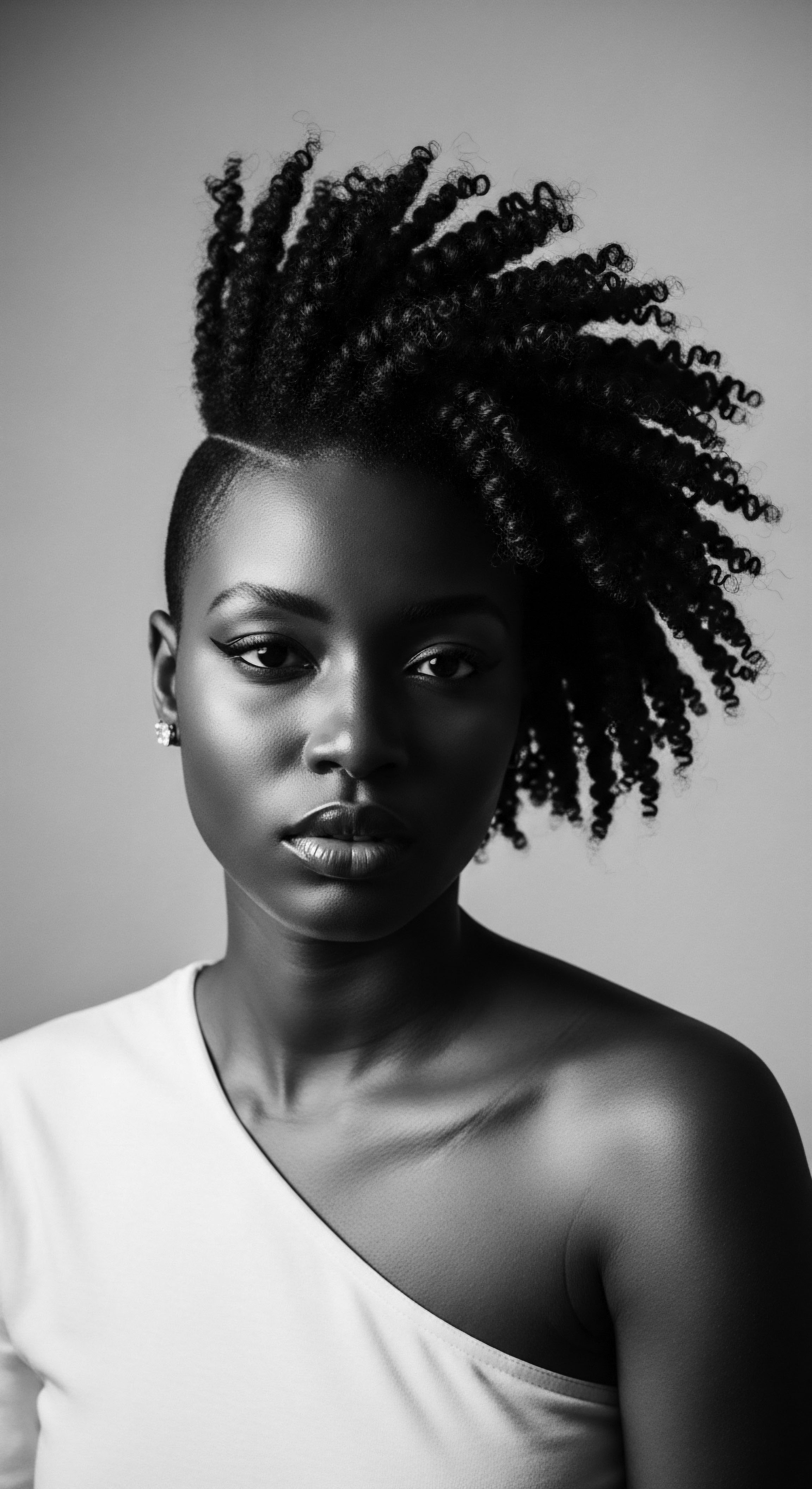
Roots
Consider for a moment the very air breathed by our ancestors, the soil beneath their bare feet, and the sun that dappled through ancient canopies. These elemental forces were not mere backdrops; they were silent architects of tradition, shaping an intimate dialogue between human ingenuity and the botanical world—a dialogue that profoundly influenced the selection of plants for the care of textured hair. The genesis of textured hair care, long before vials and labels, lay in a profound understanding of ecological rhythms and inherent plant properties, passed down through generations. This deep knowledge, woven into the fabric of daily existence, allowed communities to live in concert with their environment, adapting hair care to the unique demands of their regional climates.
The very structure of textured hair, with its coils and curls, evolved in direct response to the powerful African sun. This distinct hair type, often characterized by its elliptical follicle shape and varied curl patterns, served as a natural shield, guarding the scalp against harsh ultraviolet radiation and helping to regulate cranial temperature in intensely warm climates. Its density and unique shape permitted air circulation close to the scalp, acting as an insulating buffer against both heat and cold, a remarkable biological adaptation to diverse environments (Why Do Black People Generally, 2022). Yet, these structural advantages also presented distinct needs for moisture retention and protection from breakage, needs that local flora rose to meet.

What Foundational Climate Factors Shaped Traditional Hair Care?
The African continent, a cradle of human life and innovation, offers a spectrum of climates—from the arid stretches of the Sahel to the humid embrace of rainforests. Each zone presented its own set of environmental challenges for hair health. In dry, sun-drenched savannas and semi-desert regions, the paramount concern was maintaining moisture.
The air offered little humidity, and the sun could mercilessly strip strands of their vital lipids. Plants selected in these areas, therefore, possessed properties that sealed in hydration, created protective barriers, or offered gentle cleansing without stripping natural oils.
A prime example stems from the Sahel Region, a vast semi-arid expanse spanning West and Central Africa, perpetually battling intense heat and low humidity (UNHCR, 2021). Here, women turned to the native Ceratotheca sesamoides, a plant known locally as Ambunu. The dried leaves of this resilient plant, when mingled with water, yield a mucilaginous consistency, a natural slip that transforms the leaves into a gentle cleanser, detangler, and conditioner (Jostylin’s Ambunu Leaves, 2024). This mucilage, a complex carbohydrate, provides a cushioning effect, allowing for the careful separation of tightly coiled strands without causing undue stress or stripping the precious natural oils vital for hair integrity in such dry conditions.
It cleanses the scalp and hair without harsh detergents, preserving the hair’s natural moisture balance (Daolus Organic Products, 2024). The plant’s innate anti-inflammatory and antimicrobial qualities further support scalp health, a critical aspect in environments where dust and heat might otherwise cause irritation.
Ancestral climate conditions were core determinants in the botanical choices made for textured hair care, shaping rituals of cleansing and conditioning.
Similarly, the widespread use of Shea Butter, extracted from the nuts of the Vitellaria paradoxa tree, speaks volumes about climate’s influence. The shea tree thrives in the Savanna Belt, a zone characterized by its distinct wet and dry seasons, with extended periods of intense heat and arid air (Taylor & Francis, 2019). The butter, rich in fatty acids and vitamins A, D, E, and F, forms a protective barrier, shielding hair from the desiccating effects of the sun and wind.
For generations, it served as a vital emollient, locking moisture into coils and curls and offering a salve for sun-exposed skin (Moore, 2016). Its emollient and humectant properties were, in essence, a natural adaptation to the climatic demands, a testament to deep observational knowledge.

How Did Early Communities Identify Beneficial Plants?
The process of plant selection was not arbitrary; it was a sophisticated interplay of observation, experimentation, and inherited wisdom. Early communities possessed an intimate knowledge of their local ecosystems, discerning which plants offered relief from specific environmental stressors. This knowledge was accrued over millennia, a living library passed orally from elder to youth, often through direct participation in gathering and preparation rituals. The characteristics sought in plants for hair care were often directly linked to their observable properties:
- Slipperiness ❉ Plants producing mucilage, like Ambunu or okra (Abelmoschus esculentus) (Scribd, 2023), were prized for their detangling capabilities, making intricate styling and daily care of tightly coiled hair less damaging.
- Oil Content ❉ Seeds and fruits rich in fats, such as shea nuts, were chosen for their moisturizing and protective qualities, crucial in dry climates (Taylor & Francis, 2019).
- Astringency ❉ Some plants offered cleansing properties through saponins, allowing for effective, yet gentle, scalp purification without stripping necessary oils (Daolus Organic Products, 2024).
- Soothing Qualities ❉ Plants with anti-inflammatory properties addressed scalp irritation caused by sun, dust, or certain styling practices.
The deep connection between traditional plant selection and climate is a profound testament to ancestral ingenuity. It highlights how natural resources were not simply utilized; they were understood, respected, and integrated into a holistic approach to wellbeing, where the health of hair was inextricably linked to the surrounding natural world.

Ritual
The discernment of beneficial plants laid the groundwork for the intricate rituals that defined textured hair care across generations. These were not mere routines; they were communal practices, often sacred in their execution, reflecting a profound understanding of hair as a conduit for spiritual connection, identity, and indeed, climate adaptation. The plants chosen, therefore, informed not only the physical act of care but also the very rhythm and purpose of these hair traditions.

How Did Plant Properties Inform Styling Techniques and Tools?
The unique properties of plants like Ambunu and shea butter shaped the very techniques employed in traditional styling. Consider the challenge of detangling tightly coiled hair, particularly in arid climates where dryness increases friction and breakage. The mucilaginous slip provided by Ambunu, for instance, transformed this challenging task into a more gentle and manageable one (Jostylin’s Ambunu Leaves, 2024). Before its application, detangling could be a painstaking process.
With the introduction of Ambunu, the natural gel allowed combs, often handcrafted from wood or horn, to glide through strands, minimizing damage. This facilitated the creation of complex, long-lasting protective styles like braids and twists, which were themselves a response to climate.
Protective styles—cornrows, twists, and various forms of braiding—were not solely aesthetic choices; they were strategic adaptations. By gathering the hair, these styles minimized exposure to environmental elements such as direct sun, wind, and dust, which could otherwise lead to excessive moisture loss and physical damage. The traditional application of emollients like shea butter before or after styling helped to seal these protective styles, ensuring that the moisture locked within the hair shaft persisted for extended periods (Tom’s of Maine, 2025). This practice not only maintained hair health but also reduced the frequency of washing, a practical consideration in regions where water was a precious resource.
The tools themselves often reflected the natural resources at hand. Wide-toothed combs carved from local hardwoods, bone, or even gourds were ideal for distributing thick plant-based conditioners and detanglers without snagging delicate strands. Hair pins and adornments made from shells, seeds, or carved wood served not only decorative purposes but also helped to secure elaborate styles, ensuring their resilience against the elements. Each artifact, from the botanical substance to the crafted tool, was part of a cohesive system designed to honor and protect textured hair within its natural environment.
Traditional hair rituals, deeply connected to plant selection, were climate-responsive adaptations that preserved hair integrity and cultural aesthetics.

What Role Did Traditional Cleansing and Conditioning Play?
Traditional cleansing and conditioning practices were meticulously crafted to address the specific needs of textured hair in varying climates. In humid environments, a focus might have been on preventing fungal growth or managing excess moisture, while in dry regions, the priority shifted to retaining hydration and minimizing breakage.
| Climate Zone Arid/Semi-Arid (e.g. Sahel) |
| Plant Type Used Mucilage-rich plants (e.g. Ambunu) |
| Primary Benefit for Textured Hair Gentle cleansing, extreme detangling, moisture retention by avoiding stripping. |
| Climate Zone Savanna (e.g. West Africa) |
| Plant Type Used Fatty acid-rich plants (e.g. Shea, Baobab) |
| Primary Benefit for Textured Hair Barrier creation, deep moisturizing, sun protection for hair and scalp. |
| Climate Zone Humid/Tropical (e.g. Rainforests) |
| Plant Type Used Antifungal/Astringent plants (e.g. specific barks, some herbs) |
| Primary Benefit for Textured Hair Scalp clarification, odor control, managing excess oil, preventing build-up. |
| Climate Zone These plant choices underscore a sophisticated ancestral knowledge of botanical properties and their efficacy in diverse environmental settings. |
The traditional use of substances like Black Soap, often made with plantain peels and shea butter, provided a strong yet balanced cleansing. In areas where water was scarce, or the water itself was hard and mineral-laden, gentle cleansing methods like those offered by Ambunu were indispensable. It cleansed without the need for copious rinsing, allowing natural oils to remain intact, offering a vital advantage over harsher alternatives (Jostylin’s Ambunu Leaves, 2024).
Conditioning agents, beyond shea butter, included oils from other indigenous trees, like baobab oil (WAAM Cosmetics, 2023). These oils, rich in vitamins and essential fatty acids, were massaged into the scalp and along the hair shaft, providing deep nourishment and flexibility. The consistent application of these plant-based conditioners worked to reinforce the hair’s natural barrier, protecting it from environmental aggressors. This systematic approach, inherited from observations over millennia, demonstrates a profound intergenerational understanding of textured hair’s needs within the context of its natural habitat.

Relay
The knowledge passed down through generations concerning plant selection is not simply anecdotal; it holds profound scientific validity, a testament to the intuitive brilliance of ancestral practices. Contemporary understanding of ethnobotany, the study of how people of a particular region use local plants, frequently affirms the efficacy of these historical choices, connecting elemental biology to deep cultural meaning (Thaman, 1992). The resilience of textured hair, often perceived as challenging in modern contexts, is rooted in this heritage of climate-attuned care, offering a rich narrative for future exploration.

What Scientific Principles Underpin Traditional Plant Choices?
The selection of plants for textured hair care, guided by climatic pressures, reflects an inherent understanding of phytochemistry and its impact on biological systems. Take the aforementioned Ambunu (Ceratotheca sesamoides). Its power lies in the remarkable presence of Mucilage, a gummy substance that becomes slippery when hydrated (Ihlenfeldt, 2004). This mucilage, a polysaccharide, creates a protective, lubricious film around the hair shaft.
From a scientific vantage point, this property addresses the specific challenge of detangling highly coily hair, reducing mechanical friction and preventing breakage that can occur during manipulation, particularly in dry climates (Jostylin’s Ambunu Leaves, 2024). The plant also contains Saponins, natural cleansing compounds that produce a mild lather, effectively removing dirt and impurities without stripping the hair of its natural sebum, a crucial protective layer for textured strands (Daolus Organic Products, 2024). This mechanism is particularly important in arid conditions, where maintaining the integrity of the hair’s lipid barrier is paramount to preventing desiccation.
Similarly, Shea Butter (Vitellaria paradoxa) stands as a monumental example of scientific synergy with traditional practice. Its composition, primarily rich in oleic acid, stearic acid, and other beneficial fatty acids, allows it to penetrate and coat the hair shaft, providing a substantial emollient effect (Moore, 2016; Taylor & Francis, 2019). These lipids mimic the natural oils of the scalp, providing intense moisture and reducing transepidermal water loss from the hair and scalp, a direct counter to the drying effects of hot, dry climates.
Furthermore, the presence of unsaponifiable compounds, including vitamins A, E, and F, offers antioxidant and anti-inflammatory properties, soothing the scalp and protecting it from environmental aggressors (Taylor & Francis, 2019). The scientific analysis of these plant constituents validates the wisdom of generations who relied on them for protection and nourishment.
The scientific efficacy of traditional plant selections for textured hair is increasingly substantiated, validating ancestral wisdom through modern phytochemistry.
Other plants commonly found in traditional African hair care, such as Hibiscus (Hibiscus sabdariffa) and Okra (Abelmoschus esculentus), also exhibit mucilaginous properties, contributing to moisture and slip (WAAM Cosmetics, 2023; Scribd, 2023). The consistent thread across these plant choices is their capacity to hydrate, protect, and gently cleanse, properties that directly mitigate the challenges posed by varied African climates.

How Does Climate Adaptation Shape Cultural Legacy?
The deep intertwining of climate, plant selection, and textured hair care extends beyond mere biochemistry; it forms a bedrock of cultural legacy and resilience. The selection of plants like the shea tree is not only an ecological adaptation but also a socioeconomic pillar for many communities. The Shea Tree is a long-lived species, resilient to the semi-arid conditions of the Sahel and Savanna regions, often thriving where other crops struggle (Gwali et al.
2012). Its sustained presence provides not only the butter for hair and skin care but also food and medicinal benefits, making it an indispensable resource in regions susceptible to climate variability and food insecurity (Livelihoods Funds, 2021).
In many West African communities, shea butter production is almost exclusively the domain of women, earning it the moniker “Women’s Gold” (Moore, 2016). This traditional economic activity, directly tied to the climate-resilient shea tree, provides income, empowers women, and sustains households (Livelihoods Funds, 2021). For example, in Northern Ghana, an arid area, women farmers have relied on shea butter production as a primary source of income, crucial for purchasing food, clothing, and supporting education, especially when traditional agriculture faces increased challenges due to climate change (Livelihoods Funds, 2021). This illustrates how traditional plant selection, influenced by climate, has shaped social structures, economic stability, and the very fabric of heritage.
The ongoing efforts to understand and preserve these indigenous practices are crucial. Ethnobotanical studies often highlight the risk of losing this invaluable knowledge due to habitat degradation and the pressures of climate change (Monakhova & Kuznetsova, 2019). By recognizing the profound connection between environment, plant, and hair, we honor the ancestral wisdom that allowed communities to thrive despite formidable environmental realities.
- Shea Tree Cultivation ❉ In the Savanna belt, the Vitellaria paradoxa tree (shea) is not merely a source of oil; it is a fundamental component of agroforestry parklands, providing vital shade and improving soil conditions, thereby acting as a significant climate change adaptation measure for agriculture (Gwali et al. 2012).
- Ambunu Resilience ❉ Ceratotheca sesamoides (Ambunu) is a species endemic to Africa, widely distributed and cultivated even as a weed, highlighting its adaptability to diverse environments, including open grasslands and tree savannas with well-drained sandy soils (Ihlenfeldt, 2004).
- Baobab Adaptation ❉ The Baobab tree, another ancestral African icon, thrives in arid climates, producing fruits whose seeds yield oils rich in vitamins that are used to repair skin and hair, showcasing adaptation to water-scarce conditions (WAAM Cosmetics, 2023).
The knowledge contained within these traditional plant selections represents a profound living archive, a legacy of ingenuity that offers blueprints for sustainable practices in the face of ongoing environmental shifts. It reminds us that care for our strands has always been, at its deepest level, care for the planet that nurtures us.

Reflection
The whisper of the wind through ancient acacia leaves, the warmth of the sun on fertile soil, the very air that cradled generations—these elemental forces shaped not just the landscape but also the intimate traditions of textured hair care. Our journey through the botanical selections of our ancestors reveals a heritage that is living, breathing, and intricately connected to the pulse of the Earth. It compels us to see hair, not as a separate entity, but as a tender strand of this larger, ongoing story.
The ancestral wisdom concerning plants like Ambunu and shea butter, born from a deep observation of climate and natural properties, reminds us that holistic care is not a modern invention. It is a return to source, a re-engagement with practices that sustained and celebrated Black and mixed-race hair for millennia. These traditions speak to a profound reciprocity between humanity and the environment—a wisdom that teaches us about resilience, adaptation, and the enduring power of natural gifts. When we tend to our textured hair with reverence for these historical selections, we are not simply applying a product; we are participating in a profound legacy.
We honor the ingenuity of those who came before us, acknowledge the wisdom embedded in their choices, and carry forward a heritage that continues to redefine beauty on its own terms. The soul of a strand, indeed, stretches back through time, echoing the very climate that nurtured its beginnings.

References
- Daolus Organic Products. (2024). Ambunu Powder.
- Gwali, S. Nakabonge, G. Okullo, J.B.L. Eilu, G. Forestier-Chiron, N. Piombo, G. & Davrieux, F. (2012). Opportunities and challenges in the improvement of the shea (Vitellaria paradoxa) resource and its management.
- Ihlenfeldt, H. D. (2004). Pedaliaceae. In K. Kubitzki & B. Rudall (Eds.), The Families and Genera of Vascular Plants ❉ Volume VII. Flowering Plants. Dicotyledons ❉ Lamiales (pp. 317-329). Springer.
- Jostylin’s Ambunu Leaves Wholesale. (2024). Premium Organic – Detangling & Conditioning Leaves.
- Livelihoods Funds. (2021, February 8). Regenerating the shea butter tree.
- Monakhova, Y. B. & Kuznetsova, K. B. (2019). Plant Complexity and Cosmetic Innovation. Frontiers in Plant Science, 10.
- Moore, S. (2016, January 29). Introducing shea butter. Michigan State University Extension.
- Scribd. (2023). G7 – Chapter 2 – Development of Okra As Hair and Scalp Conditioner.
- Taylor & Francis. (2019). Shea butter – Knowledge and References.
- Thaman, R. R. (1992). Batiri Kei Baravi ❉ The Ethnobotany of Pacific Island Coastal Plants. Atoll Research Bulletin, No. 361. Smithsonian Institution.
- Tom’s of Maine. (2025, March 18). How to Use Shea Butter in Your Personal Care Routine.
- UNHCR. (2021). Sahel – Climate Risk Profile.
- WAAM Cosmetics. (2023). Discover Africa’s many beauty secrets.
- Why Do Black People Generally Have Curly Hair Despite Their Ancestors Evolving in a Hot Climate? (2022, September 20). Quora.
